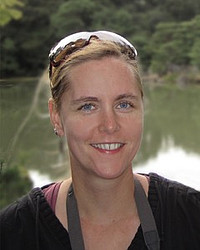The programme in the summer term 2022
June 27, 2022; 11 AM; Seminar room 1.136, Institute for Psychology, Goßlerstraße 14
Helen Blank (University Medical Center Hamburg Eppendorf): You say “tomato”, I say “tumatu” -The influence of prior expectations on perception in social interaction
Our ability to successfully interact with other people depends on recognizing and understanding other persons in different contexts. Especially, when sensory signals are degraded, informative priors can improve perception but may also lead to deception. Therefore, unravelling how the human brain combines sensory input from face and voice with prior knowledge is important. In my talk, I will present data from several studies investigating how prior expectations influence perception in social interaction. Firstly, I will contrast two functionally distinct computational mechanisms by which prior expectations can influence sensory representations of speech. Expected features of the input can be enhanced or sharpened. Alternatively, in Prediction Error accounts, expected features are suppressed and unexpected signals are processed further. We aimed at distinguishing between these two accounts by combining behavioural, univariate, and multivariate fMRI measures with computational models. Secondly, I will address the question why we are better in understanding familiar speakers with data from behavioural online studies, in which listeners could use voice context to normalize vowel perception. Finally, I will discuss how the human brain could represent the strength of prior expectations during face-identity recognition.
May 5, 2022; 3 PM; Michael-Lankeit-Hörsaal, German Primate Center
Cédric Girard-Buttoz (Max Planck Institute for Evolutionary Anthropology Leipzig): Complexity and structure of vocal communication in wild chimpanzees
Human languages’ exceptional combinatorial properties enabling endless meaning generation is in stark contrast to the very limited vocal sequence production capacities of non-human primates. This contrast led some researchers to question the suitability of vocal communication studies on non-human primates to understand the evolution of language. However, studies have rarely quantified flexibility and structure of vocal sequence production at the whole repertoire level. Here, we characterised the structure of vocal sequences across the vocal repertoire of wild chimpanzees in the Taï population. We found that chimpanzees produced 390 unique vocal sequences. Most vocal units emitted singly were also emitted in two-unit sequences (bigrams), which in turn were embedded into three-unit sequences (trigrams). Bigrams showed positional and transitional regularities within trigrams, such that certain bigrams predictably occurred either in head or tail positions in trigrams, and predictably co-occurred with specific other units. We then assessed the potential for vocal usage learning of these sequences by comparing the call ordering of two single calls, the long-distance contact call pant-hoot and the submissive call pant-grunt, into the greeting hoot sequence between two chimpanzee populations (Taï and Budongo). We found that both populations consistently differed in call ordering, with pant-hoots being emitted first in the sequence in Taï and pant-grunt first in Budongo. These differences may be linked to different social pressures related to intra-group aggression and killing. Finally, we characterised the developmental trajectory of vocal sequence acquisition throughout ontogeny. This trajectory followed key developmental milestones with the steepest increase in the diversity and length of vocal sequences around the weaning age and the adult level of vocal complexity reached at maturity. Our results demonstrate a flexible complex vocal system in wild chimpanzees, potentially socially learnt. The capacity to organize single units into structured sequences offers a versatile system potentially suitable for expansive meaning generation. Further research must show to what extent these structural sequences signal predictable meanings.


